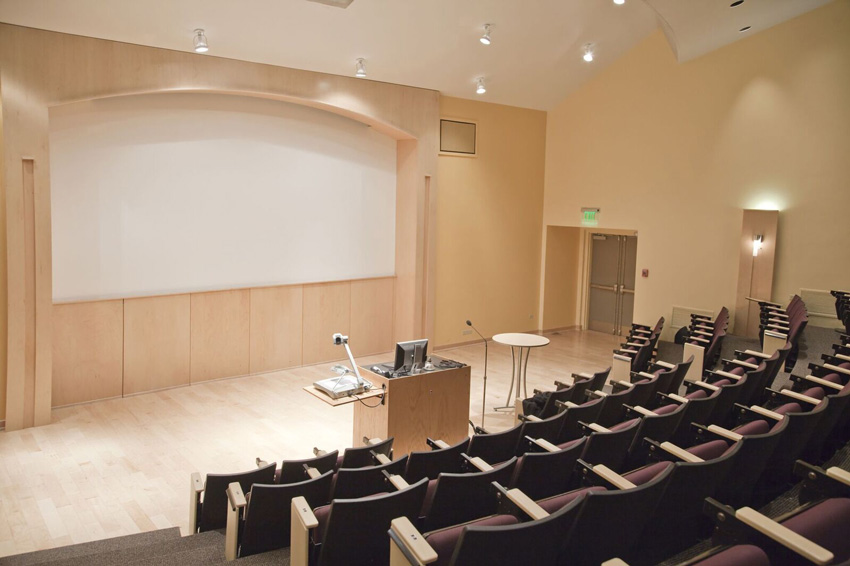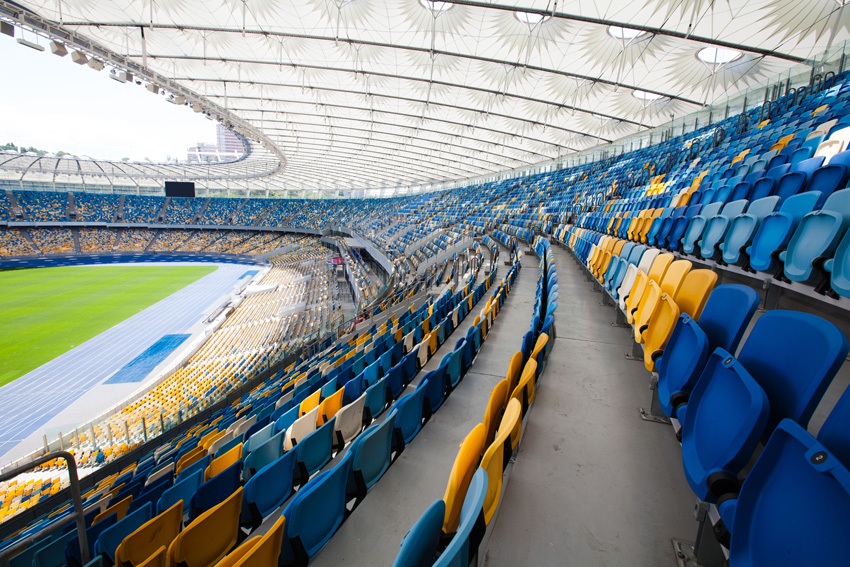Designing for People with Hearing Loss
Performance Comparison of FM/RF, IR, and Hearing Loops
There is a dramatic difference between the experiences that these three assistive listening systems offer to someone with hearing loss. In order to select the right solution for a project, its important to consider the unique performance characteristics of each type of system in terms of usability, sound quality, user preference, potential interference, ease of maintenance, universality, and the ability to be used in transient applications.

Hearing loops, FM/RF, and IR assistive listening systems offer a dramatically different experience to people with hearing loss attending a performance or lecture.
Usability
The usability of the various assistive listening systems is very different, especially when considered in terms of the experience that a person has using the systems and the number of users that each system can support.
Hearing loop systems send the audio signal directly to a person’s hearing aid or cochlear implant, enabling those people with hearing loss to enter a facility and begin accessing the signals sent over the assistive listening system by simply activating the telecoil mode in their hearing aid or cochlear implant with the press of a button. Both FM/RF and IR assistive listening systems require users to borrow receiving devices and headsets from the venue. This has a few notable setbacks, as it is not very convenient, and it takes time both before and after the engagement. When a venue has an FM/RF or an IR assistive listening system, attendees with hearing loss will need to find the desk where the equipment is available, be trained on how to use the various pieces, and check everything in and out. Another common issue is that many users are reluctant to borrow equipment due to hygiene concerns over shared headphones and ear buds.
There is also a difference in the number of people who can use a hearing loop and the number of people who can use an FM/RF or IR assistive listening system at the same time. When a hearing loop is installed into a space, anyone sitting in the area can turn on their telecoil and receive the audio signal. There is an unlimited number of simultaneous users with a hearing loop. FM/RF systems and IR systems can only be used by a person wearing a receiver. The number of people who can benefit from the assistive listening technology is limited to the number of receivers and headsets that are kept on hand at the site.
Sound Quality
There is also a dramatic difference in the sound quality that is offered from one type of assistive listening system to another. When hearing aids are fitted onto a person with hearing loss, the user participates in a process that customizes the way the hearing aid modifies the original sound to compensate for the person’s specific degree and pattern of hearing loss. It is also adjusted to meet personal preferences so the wearer enjoys the sound he or she hears. Hearing loops capitalize upon the work that has already been done by the wearer and the hearing specialists by using the person’s existing, customized hearing device to deliver the audio signal to his or her ear. When FM/RF and IR assistive listening systems deliver the audio signals through headphones or ear buds, the wearer must often remove his or her custom-fit hearing devices for the one-size-fits-all headset. In the swap, the person with hearing loss loses the clarity and customization provided by the hearing aid and instead gets distorted sounds at a higher volume.
User Preference
The convenience of using the hearing loop system and the sound quality it provides may explain why this technology often receives better reviews when compared with the other assistive listening systems. In a recent study comparing the experience of listening to a speaker in a large venue with a hearing loop, an FM/IR system with a neckloop, and an FM/IR system with headphones, 86 percent of the hearing aid users preferred listening with the hearing loop and their own hearing aid device instead of the other assistive listening systems.
Another study by Kochkin et al. asked hearing loop users to compare their listening experience in a looped venue with and without the support of the hearing loop. They rated their experience on a scale from one to 10, where one meant that the user effectively heard nothing and 10 indicated that the user heard every word of the performance. When listening without the hearing loop, only 14 percent of respondents rated their experience at eight or higher. After activating the telecoil in their hearing aid and getting the message delivered directly to their device, 86 percent of the respondents rated their experience in the venue at eight or higher.
Signal Interference
For people with hearing loss, the key problem is that the SNR is not strong enough on its own, so the signal of interest is camouflaged and weakened by other ambient sounds. Assistive listening systems improve the signal strength of the speech or presentation by cutting out the background noise and delivering the sound directly to the person’s ear. However, each type of signal—the IR, the RF, and even the hearing loop—can experience interference that compromises its strength and clarity. Infrared signals, for example, can be compromised in sunlight or whenever the direct line of sight between the receiver and the transmitter is obstructed. Radio waves from other RF devices can interact with FM/RF signals and cause interference or disruption.

By specifying a hearing loop system into a venue, designers transform the experience of the people with hearing loss in attendance, allowing them to hear announcements and be more fully engaged in the event.
Electromagnetic interference (EMI) can interfere with the signal delivered in a hearing loop system. When EMI is present, the person with hearing loss often hears a buzzing sound, which detracts from the transmitted audio signal. EMI can be caused by defective HVAC equipment and water heaters, neutral-to-earth faults, or electrical wiring that is not compliant with the National Electric Code (NEC). Most new buildings are constructed to satisfy the NEC and/or include ground fault interrupters, which minimize the occurrence of EMI. EMI is more common in older buildings and can be resolved by an experienced electrician.
Universality
Universality is also an important consideration when designing a space that needs to be accessed and understood by people of all ages with different levels of impairment and using a variety of hearing devices. The hearing loop is compatible with any telecoil-equipped hearing device, regardless of the manufacturer of the hearing device. While attendees with hearing loss must seek out the location to borrow the FM/RF and IR systems, the telecoil mode can be activated in a hearing aid with the push of a button. The hearing loop offers adults and children, with varying degrees of mobility, the clearest, most fine-tuned audio signal that can be accessed with the fewest extra steps.
Ease of Maintenance
There are also different maintenance requirements for the FM/RF, IR, and hearing loop assistive listening systems. In venues that offer the FM/RF and IR systems, the receivers and headphones and ear buds must be organized and kept clean and functional. This includes ensuring that the batteries in the receivers remain fresh enough to sufficiently power the devices. In practical application, this is often challenging. It can be difficult for staff to locate the receiving devices and headsets. Once they are found, they are often dysfunctional.
Hearing loop systems are virtually maintenance free. There is no communally shared equipment that must be regularly disinfected. There are no batteries to change. The hearing loop systems are easier for users to use and staff to maintain. And, according to the 2010 ADA Standards, if an area is equipped with a hearing loop, it is not required to also offer these FM/RF or IR assistive listening systems.
Transient Applications
Although much of the conversation thus far has focused on the experience that the assistive listening system offers a person with hearing loss in a large assembly area, people with hearing loss also struggle when trying to communicate with a person one-on-one. Talking to a teller at the bank, purchasing tickets at the box office, renewing a driver’s license, checking in at an airport, and basically any scenario where a person with hearing loss must communicate amidst a high level of ambient noise can present difficulty and cause frustration.

People with hearing loss also struggle when trying to communicate in one-on-one situations, and hearing loop systems are the only assistive listening solution that can be used in these applications.
Hearing loops are the only assistive listening system that can be conveniently used in these transient one-on-one communication situations. While FM/RF and IR systems would require that the bank tellers or customer service representatives hand over ear buds and receivers to every customer with hearing loss in the line, people can use the hearing loop technology by simply activating the telecoil mode in their own hearing aid. Once activated, the hearing loop will cut out the background noise and enable the person with hearing loss to hear the teller or sales representative with greater clarity.
Beyond convenience, hearing loops offer hearing assistance with a greater degree of privacy. The person with hearing loss never needs to ask anyone for additional equipment. Spaces equipped with a hearing loop often post signs to inform people that hearing loop technology is available. A person with hearing loss will see the sign and simply activate his or her own telecoil mode. No additional action is required from the staff members; they simply conduct the transaction as usual.
This technology can be installed in any number of places, including pharmacies, airports, retail check-out counters, libraries, information booths, and any place where clear and convenient interactions are critical to conducting daily business.









